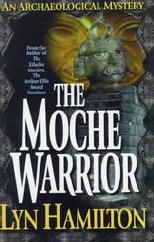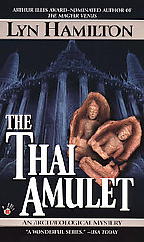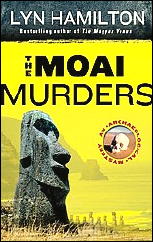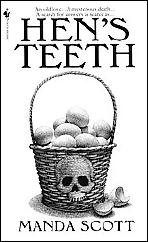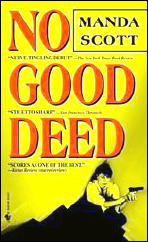September 2009
Monthly Archive
Sat 12 Sep 2009
REVIEWED BY WALTER ALBERT:
IF I HAD A MILLION. Paramount, 1932. Gary Cooper, Charles Laughton, George Raft, W. C. Fields, Jack Oakie, and 41 featured players. Screenplay by various hands, based on the novel Windfall by Robert D. Andrews. Directed by Ernst Lubitsch, Norman Taurog, Stephen Roberts, Norman McLeod, James Cruze, William A. Seiter, and H. Bruce Humberstone. Shown at Cinevent 41, Columbus OH, May 2009.
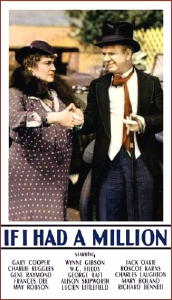
The premise of this eight-part anthology film is that wealthy John Glidden (Richard Bennett), close to death, dissatisfied with his life and wanting to do some good before he dies, decides to give his fortune away in the form of million dollar checks to strangers.
The film seems to include every name actor on the Paramount lot at the time, but the sequence that is best known is “Road Hogs,” directed by Norman McLeod. It features W. C. Fields and Alison Skipworth as former, down-on-their-Iuck vaudevillians who, with the check that Emily La Rue (Skipworth) receives, buy the car of their dreams.
When the car is demolished by a road hog, the pair buy a fleet of cars and, followed by their new purchases, each with its own driver, they take the lead in an afternoon’s drive during which they demolish the car of every road hog who tries to cross their path, until, they drive off triumphantly in the last undamaged car.
The narrative spectrum includes a forger trying, without success, to cash his check, a death-row prisoner relieved to have a fortune to leave to his wife, and, in the shortest and most pointed of the stories, directed by Ernst Lubitsch, a lowly clerk (Charles Laughton) who finds the perfect way to pay back his employer for years of indignities inflicted upon him.
As might be expected, the film is uneven, but it’s never less than entertaining, and at its best, a wonderful display of the writing, directing and acting talent available at Paramount in the early 1930s.
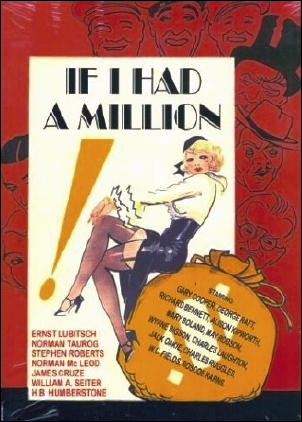
Sat 12 Sep 2009
Mystery writer Lyn Hamilton died of cancer earlier this week (September 10th) at the age of 65. At a pace of a book a year over the past 11 years, she was the author of an equal number of mystery adventures featuring her series character Lara McClintoch.
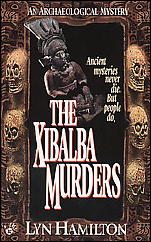
From Lyn Hamilton’s website: “The series features Toronto antique dealer Lara McClintoch, who travels the world in search of the rare and beautiful for her shop, finding more than a little murder and mayhem along the way. Each book in the series is set in a different and exotic location and calls upon the past in an unusual way.
“The first book in the series, The Xibalba Murders, was nominated for an Arthur Ellis Award for best first crime novel in Canada, and the eighth, The Magyar Venus was nominated for an Ellis award for best crime novel. The Celtic Riddle formed the basis for the 2003 Murder She Wrote TV Movie starring Angela Lansbury.”

The Chinese Alchemist (2007) had already been announced as Lara McClintoch’s final appearance.
Also from the author’s website: “Courses in both cultural and physical anthropology in her student days at the University of Toronto inspired a life-long interest in ancient cultures. Lyn was for six years the Director of the Ontario Cultural Programs Branch, the branch responsible for the licensing of all archaeology in the province as well as for museum and heritage conservation support programs.
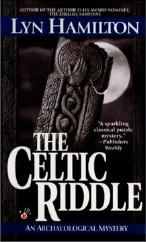
“Lyn visits each of the locales she writes about, and has led tours to come of the sites in her books. Her books have been translated in Chinese, German, Spanish, Italian, Hebrew and Turkish and will soon be available in Croatian, Greek, Hungarian and Thai.
“She was writer-in-residence at the North York Central Library in 2003, and held the same position at the Kitchener Public Library in 2004. She lives in Toronto, and like her sleuth Lara is something of an antiques addict.”
More details about the author can be found in online obituriaries on the Toronto Star and CBC websites.
The Lara McClintoch Archaeological Mysteries. The entire series was published by Berkley. The first two were paperback originals; all of the others were published first in hardcover, then in paperback.
The Xibalba Murders (1997)
The Maltese Goddess (1998)
The Moche Warrior (1999)
The Celtic Riddle (2000)
The African Quest (2001)
The Etruscan Chimera (2002)
The Thai Amulet (2003)
The Magyar Venus (2004)
The Moai Murders (2005)
The Orkney Scroll (2006)
The Chinese Alchemist (2007)
Short story:
“Stark Terror at Tea-Time.” Original story with Lara McClintoch. Included in Death Dines In, edited by Claudia Bishop and Dean James; Berkley, 2004.
Sat 12 Sep 2009
SEVEN MILES FROM ALCATRAZ. RKO Radio Pictures, 1943. James Craig, Bonita Granville, Frank Jenks, Cliff Edwards, George Cleveland, Erford Gage, Tala Birell, John Banner, Otto Reichow. Director: Edward Dmytryk.
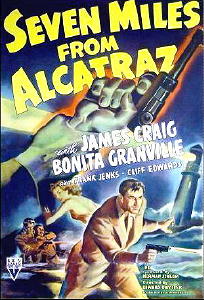
Released in January 1943, this Grade B action picture is primarily a propaganda film for the war effort, during some of its darkest days.
If a tough (but good-looking) gangster (James Craig) and a cheap (and pug-ugly) hoodlum (Frank Jenks) who’ve just broken out of Alcatraz can be convinced that the war is worthy of both their effort and sacrifice, then who’d be left on the home front who wouldn’t be?
Absolutely nobody, except perhaps a stray underground German spy or two. (And by the way, as long as you ask, yes, it is that John Banner.)
Breaking out of Alcatraz (don’t ask how — it’s a trade secret), Craig and Jenks make their way to a lighthouse somewhere in San Francisco bay, manned by a crusty lighthouse keeper (George Cleveland), his very pretty daughter (Bonita Granville), and a semi-dopey assistant (most amusingly played by Cliff Edwards). Most of the rest of the players are German agents, both male and female, and to a man (and woman), they are a dastardly lot.
There’s a whole business about codes and a secret submarine, and a whole lot of running up and down the lighthouse steps and then into a dark dank storage area beneath the main floor. Add some shooting and punching, and while there’s not a whole lot of literary value to the proceedings, the result is a full hour’s worth of Saturday-afternoon-at-the-movies and don’t-ask-questions kind of entertainment.
Fri 11 Sep 2009
Posted by Steve under
ReviewsNo Comments
A REVIEW BY DAVID L. VINEYARD:
ARTURO PEREZ-REVERTE – Queen of the South. First US edition: Putnam, hardcover, June 2004; trade paperback: Plume, May 2005.
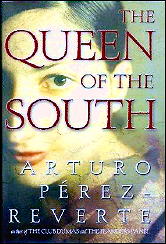
The telephone rang, and she knew she was going to die. She knew it with such certainty that she froze, the razor motionless, her hair stuck to her face by the steam of the hot water that condensed in big drops on the tile walls. R-r-ring— r-r-ring… Los Tigres Norte were on the stereo in the bedroom, singing about Camelia la tejana. Smuggling and double-crossing. She’s always feared that songs like that were omens, and then suddenly they turned out to be dark and menacing reality. Guero had scoffed, but the ringing telephone showed how wrong a man could be.How wrong and how dead. R-r-ring—r-r-ring…
So opens Arturo P?rez-Reverte’s Queen of the South, “the corrido to Teresa Mendoza,” the most accessible novel by the Spanish author of bestselling intellectual thrillers like The Club Dumas and The Seville Communion. This epic tale is the story of Teresa, who goes from the girlfriend of drug smuggling pilot Guero Davila in Culiacan, Mexico to the drug queen of the Costa del Sol in Spain in twelve busy years.
Queen of the South is P?rez-Reverte’s paean to his favorite writer Alexandre Dumas’ The Count of Monte Cristo, and indeed the classic plays a major role in both the novel and Teresa’s life. She is the modern Edmund Dantes, who is reborn as a mysterious figure of mystery and revenge.
But first she has to survive, and that is no easy job in the violent drug haunted world of the drug runners and narcocorridos who sing about them. Pursued by a pair of hitmen, Teresa flees for her life, and in due time she finds herself in Morocco working as a whore.
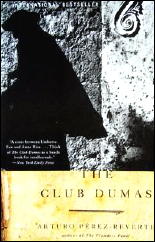
There she falls for another handsome drug runner, this one using fast cigarette boats to smuggle drugs into Spain. When they are captured, Teresa ends up in prison. And there she meets the tough smart lesbian Patti, who befriends her and gives her a copy of The Count of Monte Cristo to read.
For Teresa, the novel is a revelation, and an inspiration. Perez-Reverte is reminding us that books are powerful and matter. When Teresa emerges from prison with Patti, she puts her plans into motion, and soon she is controlling the drug traffic along the entire Costa del Sol, the Spanish Riviera.
She spares the life of one of the Mexican hitmen sent to kill her, and wins a friend and ally, her right hand man. She outwits the law and outmaneuvers her competition, becoming a legend.
And in due time she returns to Culiacan for her stunning revenge.
The novel is told in part as P?rez-Reverte’s investigation into Teresa’s life, alternating with third person accounts of her adventures. The style is clean and poetic in the Chandler mode, if the story itself is the stuff of Harold Robbins’ The Adventurers.
Combining the swashbuckling of Dumas, the seriousness of Graham Greene, the style of Chandler, and the glamour of Sidney Sheldon or Harold Robbins, Queen of the South is as satisfying as the best pulp in the Godfather style, and yet it is a serious and well written novel as well.
P?rez-Reverte made his debut with The Flanders Panel, and since has cemented his place as one of the best writers of the intellectual thriller, with one stunning book after another — The Club Dumas, The Seville Communion, The Fencing Master, The Nautical Chart, Painter of Battles, and the series of historical swashbucklers about Captain Alariste, a 16th century Spanish swordsman and mercenary that have swept Europe and are currently being prepared to reach the big screen.
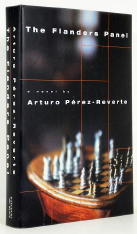
P?rez-Reverte obviously has fallen a little in love with Teresa, and you may well yourself. It is a stunning read, exciting, smart, compellingly readable, and poetic, in its own way a narcocorrido and a commentary on the society that makes heroes of violent drug smugglers whose violence spills over into the innocent streets.
Queen of the South itself is a sort of song of Teresa Mendoza, a portrait of a remarkable woman who spends twelve years and builds an empire only to risk it all it avenge the man she once loved.
You do what you can with what you’ve got. I was sure that somewhere near there (Culiacan), somebody was already composing the song that soon would be playing in Sinaloa and all of Mexico, sung by Los Tigres, or Los Tucanes, or some other legendary group. A song those tough-looking individuals with big moustaches, plaid shirts, baseball caps, and blue jeans who surrounded Julio, Elmer, and me in the same cantina — maybe at the same table — where Guero had set, would listen to, their faces stony, and each with a Pacifico in his hand nodding in silence. The story of the Queen of the South. The corrido to Teresa Mendoza.
Note: There always have been intellectual thrillers, but since the stunning success of Umberto Eco’s The Name of the Rose, the genre has become an important addenda to the thriller genre.
Arturo P?rez-Reverte is one of several Spanish writers who found new freedom in the era following the end of Generalismo Franco’s reign and lifted Spanish popular literature to bestselling status. Of those writers, P?rez-Reverte is the best, both serious and playful, compulsively readable, and a man with something to say.
Fri 11 Sep 2009
REVIEWED BY WALTER ALBERT:
MANDA SCOTT – The Crystal Skull. Delacorte Press, hardcover, April 2008. Paperback reprint: Bantam Books, February 2009. UK edition: Transworld, January 2008.
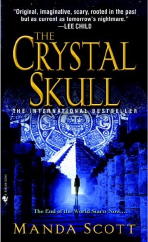
According to Mayan lore, the world will end on 21/12/2012. The only salvation for humanity lies in the activation of 12 crystal skulls entrusted to the protection of a network of keepers.
Stella Cody O’Connor, a descendant of Cedric Owens, the keeper of the ninth skull, who was murdered in 1599 after hiding the skull from the dark forces who would destroy it, with the help of her husband, Kit, retrieves the skull from a cave in which it has been buried.
This is, however, only the beginning of her task, and the novel traces, with mounting tension, Owens’ odyssey in the past and Stella’s present-day struggle to protect the sacred skull.
Owens’ odyssey takes him to the New World, where the powers of the Skull are revealed to him. The Skull is no inanimate object, the mute subject of the quest. Its keeper bonds with it, and it is that spiritual and emotional bond that is, perhaps, the most distinctive quality of this intelligent thriller, giving it an unusual and moving resonance.
Bibliographic data [expanded from the Revised Crime Fiction IV, by Allen J. Hubin] —
SCOTT, MANDA (Catriona).
The Dr. Kellen Stewart series —
Hen’s Teeth. Women’s Press, UK, pb, 1996; Bantam, US, 1999.
Night Mares. Headline Press, UK, hc, 1998; Bantam, 1999.
Stronger Than Death. Headline, UK, hc, 1999; Bantam, 2000.
Note: The series is set in Glasgow, Scotland, and environs. Dr. Stewart is a doctor, a therapist and a lesbian, and in various ways she’s personally involved with each of the cases of murder she works on.
Crime/mystery novels —
No Good Deed. Headline, UK, 2001; Bantam, US, 2002. [Nominated for an Edgar, 2003.]
The Crystal Skull. Transworld, UK, 2008; Delacorte, US, 2008.
Fri 11 Sep 2009
More authors’ entries from Part 34 of the online Addenda to the Revised Crime Fiction IV, by Allen J. Hubin. I’m still working in the H’s, with a couple of small dividends at the top and bottom:
GIBBS, HENRY CHARLES HAMILTON. 1870-1942. Name at birth of Cosmo Hamilton, q.v.
HAINES, DONAL HAMILTON. 1886-1951. Add biographical information: Born in Kalamazoo, Michigan; educated at the University of Michigan, where he also later taught journalism and freelance writing. Contributor to many magazines, including Everybody’s Magazine, The Popular Magazine, and The American Boy. Besides writing a number of boys’ sports and adventure books, the author of one mystery novel included in the Revised Crime Fiction IV. See below:
Shadow on the Campus. Farrar & Rinehart, hc, 1942. Setting: Michigan; Academia. Intended for younger readers.
HALL, GEOFFREY HOLIDAY. 1913-1981. Confirm both dates. Born in Santa Cruz, NM. The author of two mystery novels listed in the Revised Crime Fiction IV. See below. This is the author’s complete entry.
The End Is Known. Simon & Schuster, hc, 1949; Heinemann, UK, hc, 1950. Setting: New York City; Montana. Add the latter; also add film: Cineritmo, 1993, as La Fine e Nota (scw: Cristina Comencini, Suso Cecchi d’Amico; dir: Comencini). [A review of the book can be found here on this blog.]
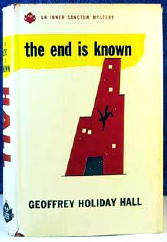
The Watcher at the Door. Simon & Schuster, hc, 1954. Setting: Vienna.
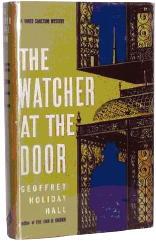
HAMILTON, CATHERINE J(ANE). 1841-1935. Add as a new author. Born in Somerset, England, of Irish parents. Lived in Ireland for more than thirty years from 1859; author of short stories, verse and serials, contributing to Weekly Irish Times and Ireland’s Own, among other periodicals.
The Flynns of Flynnville, as by C. J. Hamilton. Ward, 1879. Setting: Ireland. Novel based on “the murder of a bank-manager by a constabulary officer called Montgomery.” [Online text.]
-True to the Core: A Romance of ’98. White, 1884. [Two volumes.] Setting: Dublin. “The story of the love of a Kerry peasant girl for the ill-fated John Sheares.”
HAMILTON, COSMO. 1870-1942. Name at birth: Henry Charles Hamilton Gibbs, 1870-1942, q.v. Born in England; his working byline was based on his mother’s maiden name. Correct name and year of birth; add biographical information: Settled in the US by the 1920s; novelist and playwright, authoring many London musicals and Broadway plays. One novel and four story collections are included in his entry in the Revised Crime Fiction IV. Not all of the short fiction is criminous. Add the book of four plays below. Also of special note is the one novel, also cited below:
Four Plays. Hutchinson, UK, 1925; Little, US, 1924. Plays, with the one criminous so indicated below with a *. Note: “The New Poor” was also published separately as: Who Are They? French, 1929.
The Mother Woman
* The New Poor
Scandal
The Silver Fox
-The Princess of New York. Hutchinson, UK, hc, 1911; Brentano’s, US, hc, 1911. Silent film: Famous Players, 1921 (scw: Margaret Turnbull; dir: Donald Crisp). [The daughter of an American steel magnate heads for Europe but is waylaid on the liner by a pair of confidence tricksters.] Note: Although working behind the scenes, the 22 year old Alfred Hitchcock developed his cinematic vernacular by compiling the title cards for this film. (From the IMDB link just preceding.)
Who Are They? See Four Plays.
HANKINS, ARTHUR P(RESTON). 1880-1932. Pseudonym: Emart Kinsburn, q.v. Born in Sac City, Iowa. Add biographical information: Under his own name, besides writing several western and adventure novels, the author of two crime-related titles included in the Revised Crime Fiction IV. His shorter work appeared in many pulp magazines such as Detective Story Magazine, Western Story Magazine and Argosy All-Story Weekly.
KINSBURN, EMART. Pseudonym of Arthur P(reston) Hankins, 1880-1932, q.v. Under this pen name, the author of several western novels as well as two crime thrillers included in the Revised Crime Fiction IV. See below:
Tong Men and a Million. Chelsea House, hc, 1927. Set in San Francisco’s Chinatown: “Soft-footed Chinese gunmen stealing forth at night to shoot down the victims whom their tong has marked for destruction!”
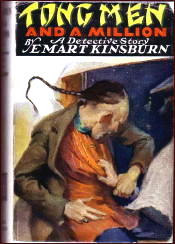
The Wizard’s Spyglass. Chelsea House, hc, 1926.
Fri 11 Sep 2009
Posted by Steve under
Authors ,
ReviewsNo Comments
PAT FRIEDER – Signature Murder. Bantam, paperback original; 1st printing, May 1998.
I’ve not found out much about the author. This is the first in a set of two mystery novels to feature a semi-disbarred lawyer named Matty Donahue. The second she wrote is Privileged Communications (Bantam, pbo, June 2000), and other than that, I’ve found nothing else online that’s solid enough to say about her for sure.
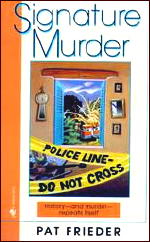
Inside the back cover of Signature Murder, though, is the following information: Like her series character Matty, Pat Frieder is a lawyer, and she lives in Albuquerque, NM. Matty lives in Sante Fe, however, and is unmarried. Her creator is also much more successful in her career, having once served as New Mexico’s Attorney General for Criminal Appeals.
While Matty, on the other hand, is barely survinving, doing essentially grunt work for a prestigious law firm that gives her a dinky office she can barely turn around in – she’s essentially a charity case, having at one time lost her license because of her involvement in a situation very much like the one that’s at the center of this book.
An eccentric elderly woman has been killed — mutilated in fact, with her hand cut off — and it may be Matty’s fault, since the handyman suspected of the deed had served time for a similar crime — hence the title — and it was Matty who brought him into the household.
So, strictly against the wishes of the two partners of the firm she’s working for, she decides to solve the case on her own – and one of the trails leads straight back to one of those very same partners.
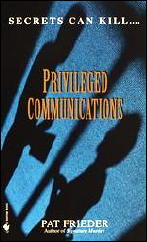
There’s also an illegal immigrant from the Middle East who’s been romancing the dead woman’s maid, forgers of Native American artifacts, victims of Fetal Alcohol Syndrome (to which Native Americans are very susceptible), a witness who’s disappeared, the grandson of a good friend of the dead woman who may inherit some money (not from the dead woman) if he’s still alive and not on drugs, a well-meaning but mostly inept public defender, and Matty’s former therapist, whose assistance is welcome but whose intentions regarding Matty could easily now be considered unethical.
And I probably missed something. The first half to two-thirds of the book makes for very easy reading, but there’s simply too much in it (nearly 300 pages of small print) for it all to fit comfortably together, not to mention one question I have – and an important one – that never gets answered. The case does get solved, however, with the help of lots of clues, including a good many false ones, causing Matty a good deal of wear and tear before she’s finished.
So it’s a good thing she’s a survivor, with at least one more adventure in her life that a book could be written about. Would I read it, if it were easily on hand? Yes, even with my complaints, Matty’s problems can easily become addictive, or so I’ve found out.
Thu 10 Sep 2009
Posted by Steve under
Reviews[4] Comments
RUTH RENDELL – A Sleeping Life. Doubleday, hardcover, 1978. UK hardcover: Hutchinson, 1978. Reprinted many times, in both hardcover and soft.

Chief Inspector Wexford’s approach to a murder is often based on intuition as well as fact, but this time around, working on the death of a middle-aged woman with no trace of background, he seems to run into stone walls no matter which way he heads.
Adding to his frustration is a domestic crisis at home as well, provoked by his daughter’s evangelical conversion to Women’s Lib.
Rendell obviously intends for the ending to come as quite a surprise, but unfortunately the secret’s too big to keep very well. The observant reader will eventually find that all the clues are pointing in one direction only.
Even so, the workmanship of this well-constructed mystery is exactly readers have come to expect from one of the best authors writing in the field today. There’s no way anyone’s going to be disappointed with this one.
– From The MYSTERY FANcier, Vol. 3, No. 3, May-June 1979
(revised).
[UPDATE] 09-10-09. In spite of the good review I gave this book, it’s been a long time since I read anything by Ruth Rendell. I always enjoyed her Wexford books, but her standalones, mostly psychological crime novels, not so much.
Thu 10 Sep 2009
Posted by Steve under
Reviews[3] Comments
IT’S ABOUT CRIME
by Marvin Lachman
JOHN DICKSON CARR – Panic in Box C. Harper & Row, US, hardcover, 1966; H. Hamilton, UK, hc, 1966. Paperback reprints include: Berkley X1587, 1968; Carroll & Graf, 1987.
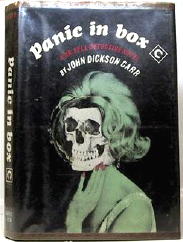
Atmosphere is always a strong element in any John Dickson Carr novel, and that is true of Panic in Box C, one of the last of his Gideon Fell series, recently reprinted by Carroll and Graf in paperback.
By the time he wrote this book, Carr was long settled in the United States, the place of his birth, and increasingly he was finding reasons for Fell to travel and detect here. This time Fell is on a lecture tour, but he detours to attend a performance of Romeo and Juliet in Westchester County.
Not only is there the obligatory murder and elements of impossible crime, but there is also effective use of the theatre, both its physical settings, and its lore, to add to an unusually good detective story. Fell remains one of my favorite detectives, a wonderfully eccentric Chestertonian type whose bluster artfully conceals his marvelous brain.
His solution in Panic in Box C is one of the best and most witty in a long career of brilliant explanations by Carr.
– From The MYSTERY FANcier, Vol. 9, No. 2, March/April 1987.
Thu 10 Sep 2009
REVIEWED BY DAN STUMPF:
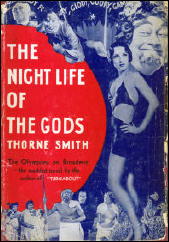
NIGHT LIFE OF THE GODS. Universal, 1935. Alan Mowbray, Florine McKinney, Peggy Shannon, Richard Carle, Theresa Maxwell Conover, Phillips Smalley , Wesley Barry. Based on the novel by Thorne Smith. Director: Lowell Sherman.
Speaking of the Obscure and Bizarre, I had the good fortune to run across a tape of Night Life of the Gods, a long-lost comedy based on a book by Thorne Smith, from a studio that was never much good at comedy.
Despite the typical Universal clumsiness — or maybe because of it — Night Life captures the flavor of Smith’s unique style quite nicely. The plot (something about a scientist who can turn people into statues and statues into people) lurches forward in typical Smith fashion towards nowhere in particular as our hero-scientist (Alan Mowbray) contends with insipid relatives, a loving secretary, a host of soliloquizing drop-ins and amorous women, all of whom, in typical Smith-fashion, seem to be pursuing plots in books of their own.
The result is hardly Great Comedy (Thorne Smith was always more whimsical than humorous), but it’s an effective translation of Smith’s peculiar ethos from page to film.
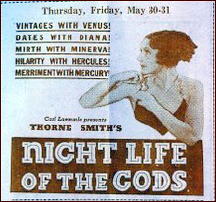
As for the actor playing the lead — in a flattering wig with his chins taped up — Alan Mowbray was always one of my favorite Unknowns. He generally played pompous, rather dull Englishmen (no one who sees him in THE KING AND I will ever remember him), and if you recall him at all, it’s probably as the Shakespearean ham in a couple of John Ford Westerns, but he was by all accounts a witty and charming man off-screen — he was one of the loyal coterie of friends who looked after John Barrymore in his later years — and his film career included highlights like the rakehell Cpt. Crawley in Becky Sharp, a bizarre Butler in the Topper films, The Devil once and George Washington twice.
« Previous Page — Next Page »





